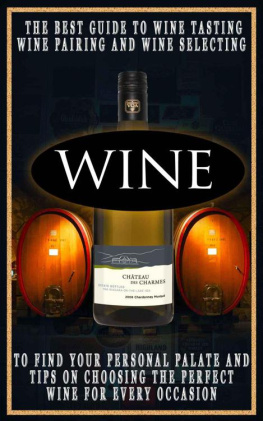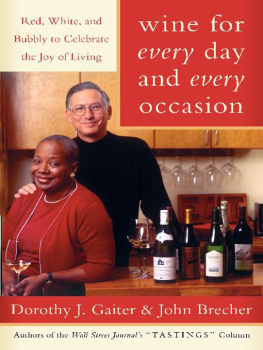Title Page
WINE - 101 TRUTHS, MYTHS AND LEGENDS
By
Roddy Button & Mike Oliver
Unofficial And Unauthorised
Publisher Information
First published in 2013 by
Apex Publishing Ltd
PO Box 7086, Clacton on Sea, Essex, CO15 5WN, England
www.apexpublishing.co.uk
Digital Edition converted and distributed in 2013 by
Andrews UK Limited
www.andrewsuk.com
Copyright 2013 by Roddy Button & Mike Oliver
The authors have asserted their moral rights
All rights reserved. This book is sold subject to the condition, that no part of this book is to be reproduced, in any shape or form. Or by way of trade, stored in a retrieval system or transmitted in any form or by any means, electronic, mechanical, photocopying, recording, be lent, re-sold, hired out or otherwise circulated in any form of binding or cover other than that in which it is published and without a similar condition, including this condition being imposed on the subsequent purchaser, without prior permission of the copyright holder.
Amusing Names
- In South Africa the wine producer, Charles Back, has been irritating the French Regional Wine Authorities, especially in the Rhone, by using the same grapes as the AC Rhone wines and giving his wines a GOAT name instead of COTE (he keeps lots of goats on his wine farm Fairview in Paarl). So, instead of Cotes du Rhone he produces Goats Do Roam, and for Cotes du Rhone Villages he has Goats Do Roam in Villages. For Cote Rotie he makes Goat Roti (same 100% Syrah as Cote Rotie). He has expanded his range to annoy Bordeaux wines with Bored Doe (he also keeps deer), and Burgundys Cote dOr with his new Goats Door. Long may he continue as they are fine quality wines.
- The American wine, Starboard, is so named because Randall Graham, with his vineyards in California, cannot call it port although it has the exact clones of grapes taken from Oporto in Portugal. He also has Syrah clones from Chateauneuf-du-Pape which he calls Old Telegram (aping Vieux Telegraphe (Old Telegraph), a top producer in the AC).
- Using a different image of Marilyn Monroe on the label each year, Californias Nova Wines produces a wine called Marilyn Merlot. The images are licensed to Nova Wines by Marilyn Monroes estate.
- Australia celebrates and specialises in odd or funny names for wines, though they are usually of good quality. Here are six of the best - By Farr, Mad Fish Bay, Lazy Ballerina, Turkey Flat, Ten Minutes by Tractor, Yarra Yarra and an order to Mount Mary! Two Lesser quality slightly rude ones are - Bitch (the back label repeats this 77 times!) and Naked on Roller Skates (with an appropriate picture on the label!).
- Even the French are suddenly having a sense of humour when naming new French wine brands - but mainly big sellers from the south. Elephant on a Tightrope (from Vin de Pays dOc), Arrogant Frog, and Frogs Piss (both VDQS wines), Vin De Merde (Languedoc-Roussillon), and finally - Fat Bastard (which sells 400,000 cases in the USA alone, a marketing phenomenon).
- The Hungarian winery Neszmely produces a wine with an unpronounceable (outside Hungary) grape name, so they decided to call it The Unpronouncable Grape. The actual grape name is Cserszegi Fuszeres, the pronunciation of which approximates to Chair- sheggy Foo-share-us.
- Cats Pee on a Gooseberry Bush comes from New Zealand and is a very dry and pungent Sauvignon Blanc. Its from Coopers Creek winery, which also produces Fat Cat Chardonnay and Tom Cat Merlot. They give part of their profits to the local SPCA to protect cats.
- Bulls Blood, from Eger in Hungary, was a top-selling wine in the UK during the 1960s to 80s. The name comes from the Siege of Eger by the Turks in 1552 - the Eger soldiers drank the local red wine to fortify themselves in battle and it stained their beards and white tunics red. The superstitious Turks thought they were drinking the blood of bulls to make themselves fierce and became fearful and demoralised and ran away, ending the siege. Now the good burghers of Eger have decided that Bulls Blood had too down-market an image and have renamed the wines Egri Bikaver. From 2004, they have gained protected origin status. They have the same blend of three grapes, but now have a posher name.
Champagne
- It was the British Navy in 1689 that first introduced the practice of breaking a bottle of champagne on the hull to baptise and launch a ship. Its bad luck for the bottle not to break, first time, on impact, and its common practice nowadays to prepare the champagne bottle beforehand, to ensure it shatters, by scoring the middle using a diamond cutter. Its not true that the champagne bottle didnt break on the launch of the Titanic. The White Star Line never had a baptism launch ceremony for their ships - they just hit the blocks and tackle and let her slide into the water. As a Titanic riveter said, They just builds er and shoves er in.
- On average there are 49 million bubbles in a 75cl bottle of champagne. The finer the champagne the smaller the bubbles, which can result in over 60 million bubbles per bottle for fine vintage champagne. This was discovered by the eminent scientist William Lemeck.
- Lemeck also measured the average pressure of CO2 in a champagne bottle at 5.5 atmospheres, which is over three times the pressure in a car tyre. When shaken vigorously and opened (as on the F1winners podium) the champagne cork can exit the bottle at up to 50 miles an hour (80kph).
- Louis Roederer Cristal Champagne was designed and produced exclusively for Tsar Alexander II of Russia in 1876. The Tsar feared assassination (quite rightly), so he wanted his champagne bottles to be made of clear glass, and the bottoms flat so that he could see through them and also to prevent hiding poison or a small bomb within them. Cristal is viewed as the first ever Prestige Cuvee and is still made to the original spec - a transparent flat-bottomed lead crystal bottle, with a gold label and a golden foil.
- A new study by Dr Gerard Liger-Belair of Reims University, found that it is the bubbles that give champagne its distinctive depth of flavour. The bubbles contain up to 30 times more flavour than the champagne itself and have a very different chemical fingerprint to the liquid. The constantly rising, bursting and collapsing bubbles release aroma compounds on a continuous cycle.
- Champagne is rarely made from a single grape variety. Its usually made from three grape varieties blended together - Pinot Noir is the most planted at 40%, then Pinot Meunier at 35% (both black grapes), and Chardonnay at 25%. Four other varieties are allowed, but they make up less than 1% of all plantings and are historic curiosities - Arbanne, Petit Meslier, Pinot Blanc and Pinot Gris.
- Winston Churchill loved Pol Roger Champagne - he first drank it in 1908 and was totally loyal to it until his death 57 years later. He often drank three or more bottles a day but still functioned as a leader! He also named his favourite racehorse Pol Roger. In 1975, to commemorate the 10 th anniversary of his death, the House named a new Prestige Champagne Cuvee after him - Cuvee Sir Winston Churchill. The blend is one of immense character, a robust structure of maturity and great class. The blend is still a well-kept secret.
- As a special Valentines Day promotion in 2012, the Cadogan Hotel in London offered champagne baths. Guests could choose between having their bath filled with vintage Louis de Custine for 4,000, Perrier Jouet for 6,000, Perrier Jouet Ros for 8,000, or vintage Dom Prignon for 25,000. Which was the most popular? The 25,000 Dom Prignon!
Closures And Openers
- Before corks were invented as the proper closures for wine vessels/bottles, a variety of methods were used to try to stop the wines from oxidising and spoiling. In Greek times they often poured a thin layer of oil on top of the wine in an amphora to keep the air from spoiling it. Romans have now been proved to have used cork stoppers in 1 st century AD in Spain and Portugal for their wines in clay vessels and pots. Rags soaked in oil were also used to stop up jugs of wine. This carried on even with the invention and use of wine bottles in the 17 th century.
Next page










